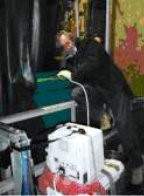Why undertake pregnancy diagnosis in deer?
The principal reason for conducting pregnancy diagnosis in farmed deer herds is to make informed decisions about hind culling. Farmers generally prefer to cull hinds primarily on reproductive productivity. Non-pregnant (‘dry’) hinds are often drafted for slaughter before the onset of winter, thus reducing herd feeding costs on non-productive animals.
However, pregnancy diagnosis can also serve other purposes:
- ensuring that in-calf sale hinds are indeed pregnant;
- measuring the success of artificial insemination (AI); and
- allocation of hinds to calving groups based on expected calving date. Repeated scanning can be used to check for abortions.
How do you confirm pregnancy in hinds?
The most reliable method of pregnancy diagnosis in hinds is real-time ultrasound scanning. This requires a specialist operator with the appropriate equipment. Equipment for visualising the pregnancy includes rectal probes (mainly for early pregnancy detection) and flank scanners (mainly for later pregnancy detection).

Early pregnancy scanning
 This is usually performed in late May to mid-June at between 30 and 80 days of gestation. For AI hinds it is usually performed 40-50 days after insemination. Visualisation of the foetus under 25 days of age is difficult so it is usual to scan no earlier than 25 days after stag removal. Foetal ageing can be performed in cases where farmers wish to select for early conceiving hinds (see DEERSelect) or to draft hinds into early and late calving groups (see Foetal Ageing). Through-put of hinds for scanning ranges from 500-1500 per day depending on operator and crush use.
This is usually performed in late May to mid-June at between 30 and 80 days of gestation. For AI hinds it is usually performed 40-50 days after insemination. Visualisation of the foetus under 25 days of age is difficult so it is usual to scan no earlier than 25 days after stag removal. Foetal ageing can be performed in cases where farmers wish to select for early conceiving hinds (see DEERSelect) or to draft hinds into early and late calving groups (see Foetal Ageing). Through-put of hinds for scanning ranges from 500-1500 per day depending on operator and crush use.
Late pregnancy scanning
Later scanning is usually performed with a flank scanner and is invariably done with hinds standing in the pen. Through-put can range from 1500-2500 per day. There are limited opportunities to age foetuses as the scan image cannot encompass the entire foetus…however, some operators can distinguish early and late conceived calves from flank scans.
What does it cost?
Cost will vary with operator but generally ranges from $2.00-$3.50 per hind. Early booking of operators is important due to the limited duration of the season (especially for early pregnancy scanning).
Other methods
Some farmers assess the pregnancy status of hinds by checking udder development and flank swelling (‘ballotment’) within a few weeks of the calving season. This method can be plagued by individual hind variation in the development of an udder, but many farmers find it useful for allocating hinds to calving groups.
Foetal ageing is the assignment of an estimated age of a foetus (in days) at the time of ultrasound scanning within the first trimester (within the first 2-3 months) of pregnancy. During this period the foetus undergoes a uniform growth and development pathway that can be easily visualised through real-time ultrasonography. With practice and regular calibration, ultrasound scanners can assess foetal age from the real-time images of the foetus and associated tissues of pregnancy.
More resources
Revol, B., Wilson, P.R. (1990) Rectal ultrasonographic pregnancy diagnosis and foetal ageing of red deer. Department of Veterinary Clinical Sciences, Massey University, Palmerston North, NZ.
Improve my scanning: To view the technical manual for scanners, click here >>
More resources
Bingham, C.M., Wilson, P.R., Davies, A.S. (1988) Real-time ultrasonic scanning for estimation of foetal age in farmed red deer. Proceedings of a Deer Course for Veterinarians. Deer Branch NZVA 5: 41-54.
Revol, B., Wilson, P.R. (1989) Ultrasonographic pregnancy diagnosis in red deer. Proceedings of a Deer Course for Veterinarians. Deer Branch NZVA 6:36-54.
Lawrence, D.W., Linney, L. (1998) Utilising data from ultrasound scanning for pregnancy. NZVA Deer Branch Conf. Proceedings Vol15/61-64
Scanning a valuable tool, G Asher, Popular Deer Industry News article (2003)
Information on best practice pregnancy scanning is available in a convenient DINZ Deer Fact sheet. Download your own copy here >>
To download the Foetal Ageing Scanning Manual (for operators), click here >>

